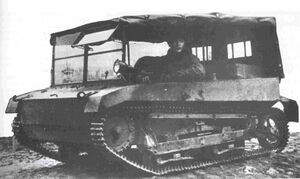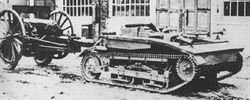Engineering:C2P
| C2P | |
|---|---|
 C2P artillery tractor | |
| Type | artillery tractor |
| Place of origin | Poland |
| Service history | |
| In service | 1937-1945 |
| Used by | Poland, Nazi Germany |
| Wars | World War II |
| Production history | |
| Designer | Janusz Łapuszewski |
| Designed | 1933 |
| Manufacturer | Państwowe Zakłady Inżynierii |
| Unit cost | zl 33,000 |
| Produced | 1937-1939 |
| No. built | 196-310 |
| Variants | TKS-D |
| Specifications (C2P plus 40 mm Bofors in tow) | |
| Mass | 2,750 kg (6,060 lb) |
| Length | 2.85 m (9 ft 4 in) |
| Width | 1.82 m (6 ft 0 in) |
| Height | 1.65 m (5 ft 5 in) |
| Crew | 1 |
| Passengers | 3 |
| Engine | 6-cylinder Fiat 122B (PZInż 367) petrol 46 hp (34 kW) at 2,600 rpm |
| Power/weight | 16.7 hp/ton |
| Suspension | Bogie on leaf spring, four rubber-tyred wheels each side |
| Ground clearance | 30 cm (12 in) |
| Fuel capacity | 70 L (18 US gal) |
Operational range | 150 km (93 mi) on road 110 km (68 mi) off-road |
| Speed | 40 km/h (25 mph) on road 20 km/h (12 mph) off-road |
C2P was a Polish light artillery tractor. Designed in the 1930s, it was the basic tractor of Polish anti-aircraft artillery during the 1939 Nazi and Soviet invasion of Poland. There are only two surviving vehicles, both in private hands in Poland.[1]
Development
The origins of the design can be traced to the Carden Loyd tankette of the 1920s. In 1929 Poland bought 10 or 11 Mark VI tankettes with a licence for their production, and used them for development of their own TK tankette series. In October 1931 Polish General Staff expressed interest in a small, highly mobile artillery tractor intended for 75 mm field guns in Polish service at the time.[2] In 1932 Janusz Łapuszewski and A. Schmidt of the BBTBP institute ("Armoured Forces Technical Study Bureau") designed a small, fully tracked artillery tractor based on TK-3 tankette. It was designed to tow 40 mm Bofors anti-aircraft guns, but could also tow other light and medium artillery used by the Polish Army, such as the modernised 75 mm Schneider guns and 100 mm Skoda howitzers.[3][4][5][6][7] For heavier guns it was to be eventually replaced in Polish service with the PZInż 343 wheeled tractor, but only a couple of these were completed before the war.
Initially designated C2T (Ciągnik 2-tonowy, "Trailer, 2-Tonne"),[8] the design looked promising and the following year the first prototype was constructed by the PZInż works.[9] The original C2P design was basically a TK-3 tankette razee: it included all elements of the undercarriage and traction system,[10] with the armoured fighting compartment removed and replaced with a simple open cockpit with seating for four crew members: one driver and three passengers. The prototype was completed on 1 July 1933 and included some modifications to the Carden Loyd suspension designed for the TKS tankette.[2]
The prototype was a promising vehicle. The design, to some extent similar to French Renault UE tractors, was nevertheless both more advanced, more reliable and faster than its French counterpart.[3] During trials it was discovered that in ideal conditions the C2P could tow a 40 mm Bofors anti-aircraft gun at a speed of 30 to 40 km/h (19 to 25 mph) on a good road,[11] and that similar speeds were achieved during cross-country trials.[5][6] Earlier C4P tractors were significantly slower, towing the guns at 12 km/h (7.5 mph).[12]
However, it was discovered that the rear of the vehicle was overloaded and that the vehicle's manoeuvrability was far from satisfactory.[13] To counter the first problem, the rear tension wheels were enlarged, equipped with leaf springs and lowered to the ground, thus converting them to driving wheels.[2] The problem with steering the tractor under heavy load was eventually solved by adding two steering clutches to both sides of the suspension system.[9] The latter modification in 1938 was included also in the development of the TKS tankette (in the TKS-B variant).[9] However, by then the serial production of TKS was stopped and in the end the C2P's undercarriage remained distinctive.[9] However, as both designs were being developed simultaneously at the same facility, both were supervised by Rudolf Gundlach and their designers sometimes referred to the C2P as "ciągnik TKS" (TKS tractor),[2] some sources call C2P a development version of TKS, which is not entirely true.[10]
After the second round of trials the prototype was also equipped with a simple windshield and a folding tarpaulin roof to protect the crew from rain or snow.[7] On 20 January 1936 the prototype left the PZInż factory for the third round of road tests.[7] The vehicle spent the best part of February travelling across Poland with a 75 mm gun attached. In June and July the tests were resumed, this time with a 1,480 kg (3,260 lb) fuel trailer, and again in September, towing the new Bofors 40 mm gun (Polish designation wz. 36 Bofors).[7] Altogether the prototype covered over 4,000 km (2,500 miles) without a serious malfunction.[7] On 15 February 1937 the trials ended and the C2P was proposed for serial production.[7]
Production
Serial production was started in 1937 at the F-1 factory of the PZInż holding at Czechowice near Warsaw.[8] The C2P replaced TKS on the production lines, which meant that the production could start quickly, as both vehicles shared many components.[7] According to newest research, until September 1939 no less than 316 were delivered to the Polish Army (earlier publications gave smaller figures).[14] An additional 117 were on order, to be completed from December 1939 to 1940.[14]
Operational history
Although initially designed for field artillery, in the end all C2P tractors were attached to anti-aircraft artillery units as the primary vehicle for towing the Bofors 40 mm gun, two for every gun: one towed the gun itself, the other towed an ammo caisson carrying 400 shells.[7] Both trailers also carried the gun's crew of 5 (plus two drivers), as well as up to 160 shells.[6][7] 292 tractors were used in regular units (with 31 A-type four-gun batteries and 11 B-type two-gun batteries).[14]
Variants
In 1936 two C2P tractors served as the basis for the TKS-D tank destroyer prototypes.[15]
Users
The C2P tractor was primarily used by the Polish Army. A number of C2P tractors were captured by the invading Wehrmacht and were pressed into German service under the designation of Artillerie Schlepper C2P(p) ("artillery tractor, C2P, Polish").[16][17]
See also
- Universal Carrier
- M29 Weasel
- Komsomolets armored tractor
- Raupenschlepper, Ost
- Renault UE
References
Citations
- ↑ Krajewski 2011, pp. 926-927.
- ↑ 2.0 2.1 2.2 2.3 Magnuski 1995, p. 42.
- ↑ 3.0 3.1 Zasieczny 2006, p. 42.
- ↑ Jurga 1990, p. 72.
- ↑ 5.0 5.1 Truszkowski 1973, p. 237.
- ↑ 6.0 6.1 6.2 Kopczewski 2004, p. 60.
- ↑ 7.0 7.1 7.2 7.3 7.4 7.5 7.6 7.7 7.8 Magnuski 1995, p. 43.
- ↑ 8.0 8.1 Jurga 1990, p. 81.
- ↑ 9.0 9.1 9.2 9.3 Magnuski 1995, p. 36.
- ↑ 10.0 10.1 Jurga 1990, p. 74.
- ↑ Truszkowski 1973, pp. 221, 237.
- ↑ Truszkowski 1973, p. 221.
- ↑ Magnuski 1995, pp. 42-43.
- ↑ 14.0 14.1 14.2 Białkowski, Rafał. Polskie ciągniki do armaty przeciwlotniczej kal. 40 mm. „Poligon” Nr. 3/2012 (32), p. 27-28, ISSN 1895-3344 (in Polish).
- ↑ Magnuski 1995, p. 41.
- ↑ Carruthers 2011, p. 76.
- ↑ Magnuski 1995, p. 48.
Bibliography
- Carruthers, Bob (2011). Panzers at War 1939-1942. Coda Books Ltd. ISBN 978-1-908538-24-6. https://books.google.com/books?id=zzBForupwBoC&pg=PT70.
- Jurga, Tadeusz (1990). Obrona Polski 1939. Instytut Wydawniczy Pax. ISBN 978-83-211-1096-7. https://books.google.com/books?id=991JAAAAIAAJ.
- Kopczewski, Marian (2004). Obrona powietrzna wojska polskiego w latach 1920-2000. Warsaw: Wydawnictwo Adam Marszałek. ISBN 978-83-7322-988-4. https://books.google.com/books?id=2NYhAQAAIAAJ.
- Krajewski, Rafał (2011). Kazimierz E. Oczoś. ed. "Odbudowa pojazdów zabytkowych z wykorzystaniem nowoczesnych technik inżynierskich". Mechanik (Agenda Wydawnicza SIMP) 84 (11/2011). ISSN 0025-6552. http://www.mechanik.media.pl/pliki/do_pobrania/artykuly/2/4078_krajewski11.pdf. Retrieved 4 September 2014.
- Magnuski, Janusz (1995). Karaluchy przeciw panzerom. Czołgi w boju. 1. Warsaw: Pelta. pp. 50. ISBN 83-85314-06-7.
- Smaczny, Henryk (2001). Polskie budownictwo wojskowe i przemysł zbrojeniowy, 1919-1939. Białystok: Polskie Stowarzyszenie Morskie-Gospodarcze im. Eugeniusza Kwiatkowskiego, Okręg Podlaski. pp. 416. https://books.google.com/books?id=Kny2AAAAIAAJ.
- Truszkowski, Stanisław (1973). Bordziłowski, Jerzy. ed. "Polska artyleria plot. w dwudziestoleciu 1919-1939". Wojskowy Przegląd Historyczny (Warsaw: Ministerstwo Obrony Narodowej) 4: 201–249.
- Zasieczny, Andrzej (2006). Broń Wojska Polskiego 1939-1945: wojska lądowe. Alma-Press. ISBN 978-83-7020-354-2. https://books.google.com/books?id=npchAQAAIAAJ.
 |




